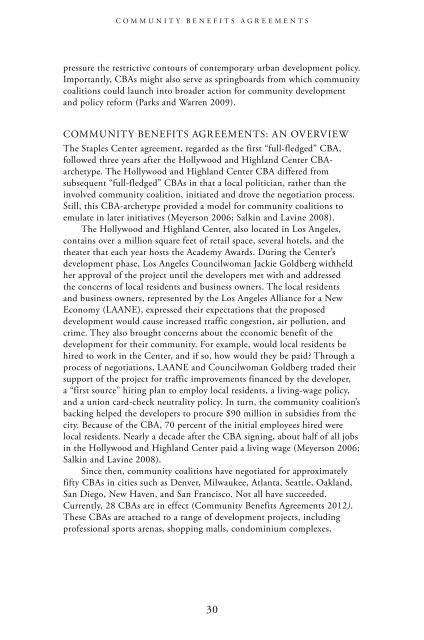DEFINING PROBLEMS. SHAPING SOLUTIONS . - School of Social Service ...
DEFINING PROBLEMS. SHAPING SOLUTIONS . - School of Social Service ...
DEFINING PROBLEMS. SHAPING SOLUTIONS . - School of Social Service ...
You also want an ePaper? Increase the reach of your titles
YUMPU automatically turns print PDFs into web optimized ePapers that Google loves.
C O M M U N I T Y B E N E F I T S A G R E E M E N T S<br />
pressure the restrictive contours <strong>of</strong> contemporary urban development policy.<br />
Importantly, CBAs might also serve as springboards from which community<br />
coalitions could launch into broader action for community development<br />
and policy reform (Parks and Warren 2009).<br />
Community Benefits Agreements: An Overview<br />
The Staples Center agreement, regarded as the first “full-fledged” CBA,<br />
followed three years after the Hollywood and Highland Center CBAarchetype.<br />
The Hollywood and Highland Center CBA differed from<br />
subsequent “full-fledged” CBAs in that a local politician, rather than the<br />
involved community coalition, initiated and drove the negotiation process.<br />
Still, this CBA-archetype provided a model for community coalitions to<br />
emulate in later initiatives (Meyerson 2006; Salkin and Lavine 2008).<br />
The Hollywood and Highland Center, also located in Los Angeles,<br />
contains over a million square feet <strong>of</strong> retail space, several hotels, and the<br />
theater that each year hosts the Academy Awards. During the Center’s<br />
development phase, Los Angeles Councilwoman Jackie Goldberg withheld<br />
her approval <strong>of</strong> the project until the developers met with and addressed<br />
the concerns <strong>of</strong> local residents and business owners. The local residents<br />
and business owners, represented by the Los Angeles Alliance for a New<br />
Economy (LAANE), expressed their expectations that the proposed<br />
development would cause increased traffic congestion, air pollution, and<br />
crime. They also brought concerns about the economic benefit <strong>of</strong> the<br />
development for their community. For example, would local residents be<br />
hired to work in the Center, and if so, how would they be paid? Through a<br />
process <strong>of</strong> negotiations, LAANE and Councilwoman Goldberg traded their<br />
support <strong>of</strong> the project for traffic improvements financed by the developer,<br />
a “first source” hiring plan to employ local residents, a living-wage policy,<br />
and a union card-check neutrality policy. In turn, the community coalition’s<br />
backing helped the developers to procure $90 million in subsidies from the<br />
city. Because <strong>of</strong> the CBA, 70 percent <strong>of</strong> the initial employees hired were<br />
local residents. Nearly a decade after the CBA signing, about half <strong>of</strong> all jobs<br />
in the Hollywood and Highland Center paid a living wage (Meyerson 2006;<br />
Salkin and Lavine 2008).<br />
Since then, community coalitions have negotiated for approximately<br />
fifty CBAs in cities such as Denver, Milwaukee, Atlanta, Seattle, Oakland,<br />
San Diego, New Haven, and San Francisco. Not all have succeeded.<br />
Currently, 28 CBAs are in effect (Community Benefits Agreements 2012).<br />
These CBAs are attached to a range <strong>of</strong> development projects, including<br />
pr<strong>of</strong>essional sports arenas, shopping malls, condominium complexes,<br />
30
















